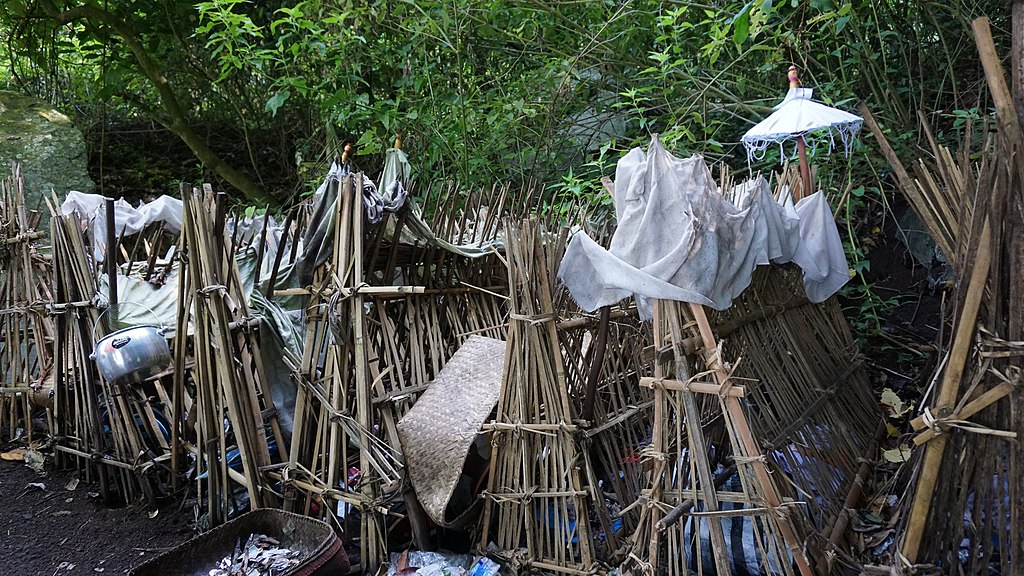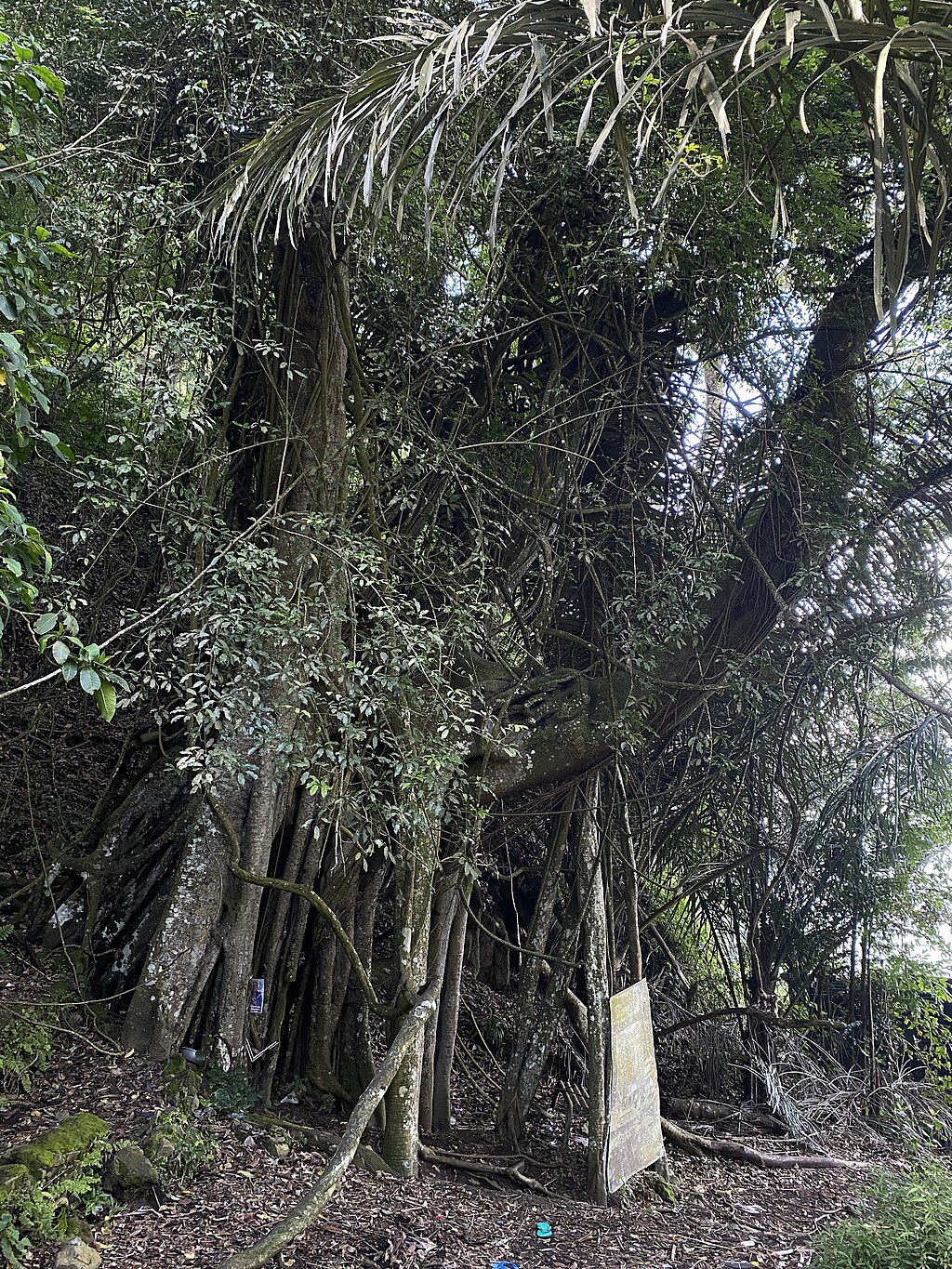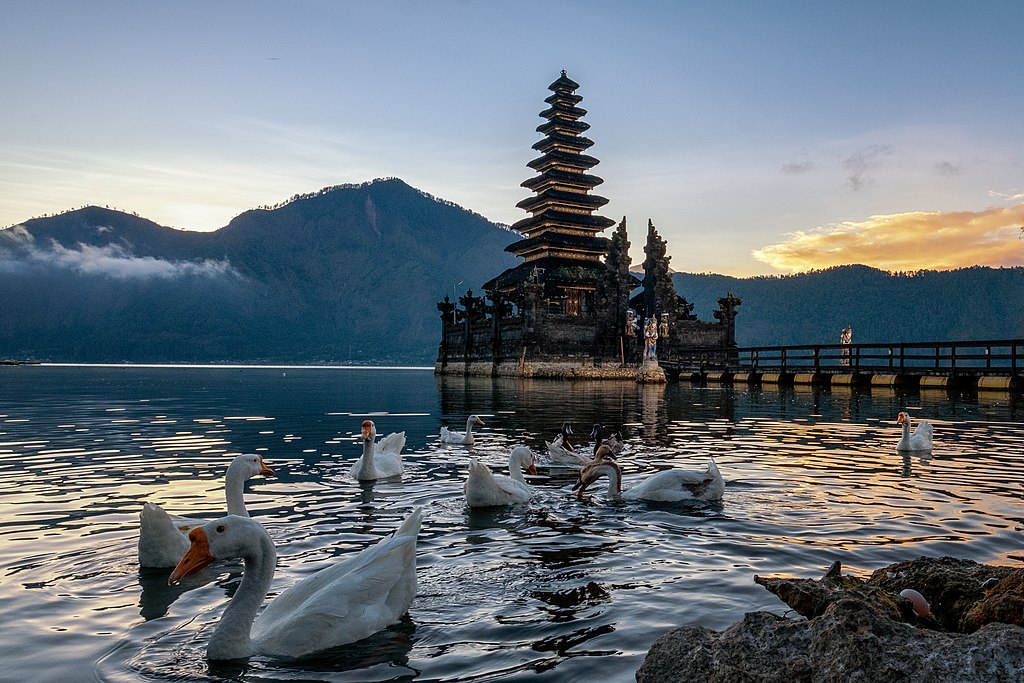Trunyan Village, Unique Civilizations
Trunyan village is an ancient village inhabited by the Bali Aga who are descendants of the first Balinese, this community lives in a very different way compared to the rest of the population of Bali. The Trunyan village temple is called Puser Jagat which means vessel of the universe and its architecture is unusual and is erected in the protective shade of a massive banyan tree.
 Lake in the crater of Mount Batur with Trunyan village on the shore. Bangli Regency, Bali, Indonesia. LBM1948, CC BY-SA 4.0, via Wikimedia Commons
Lake in the crater of Mount Batur with Trunyan village on the shore. Bangli Regency, Bali, Indonesia. LBM1948, CC BY-SA 4.0, via Wikimedia Commons
Unique civilizations
Trunyan (where it stores many very unique civilizations such as a completely different burial system with tradition in the southern part of Bali). Likewise, this lake has been trained by the eruption of Mount Batur that occurred in past centuries, can now be included Lake Batur is a volcanic lake.
The villagers of Trunyan have a strange way of treating their dead. Instead of cremating the bodies or burying them they place them just below the banyan tree and the smell is mysteriously masked by the fragrance of a Taru Menyan tree growing nearby. Taru means “tree” and menyan “smelling/fragrant” the village name Trunyan also derives from this.
In Trunyan not only are the dead not cremated or buried but simply placed on the ground and surrounded by bamboo cages to protect them from animals, it seems that bones often disappear victims of monkeys that roam in the forest.
Skulls collection
A macabre collection skulls and bones are lined up on the nearby stone platform. The women of the Trunyan village are prohibited from entering the cemetery when a body is brought there. It is believed that if a woman goes there at this time, a disaster will strike the village such as a landslide or a volcanic eruption. There we also believe that if we burned the dead it would cause problems with the volcano.
11 (eleven)
The village is dominated by merus which are the mirror of the 11 bodies exposed in the cemetery. The number 11 having an important meaning in Hinduism is why there are just 11 bamboo cages with bodies in them. When all the cages are filled with the dead, the villagers then remove the oldest ones, which they move to an altar where the dead man’s head will be placed.
Namely that in Trunyan there are 3 cemeteries accessible by boat: one being intended for the deceased married or who died of natural causes who will have the right they will have their body covered with white cloth and will be at Semah Wayah, their body will be then surrounded by the famous bamboo cage.
Those who died of unnatural causes: accident, suicide murder will go to Semah Bantas and children or those who have not married will go to Semah Muda. These dead will be buried.

Bali Aga village, inhabited by descendants of the original Balinese, who do not cremate or bury their dead, but just lay them out to decompose, bones can be found on the ground. Paracetamol, CC BY-SA 3.0, via Wikimedia Commons
How to get there?
In the past, Trunyan was only accessible by boat. Today, you can go there by car, however, the road is very steep and even dangerous in places. To get there, the first step is to travel to Kintamani area, Bangli district. You then have to go down to Lake Batur and go to the end of the road (opposite bank to the natural springs).
Terunyan port (Dermaga Terunyan)
If you want to visit this civilization, from Denpasar, take the Jalan Raya Kintamani towards Bangli. After approximately 45 kilometers (28 miles), you will reach the village of Terunyan. Turn right at the main junction in the village and follow the signs for Dermaga trunyan. The port is located approximately 2 kilometers (1.24 miles) from the junction.

A dock at Trunyan cemetery. Eka343, CC BY-SA 4.0, via Wikimedia Commons
Here are some additional tips for getting to Dermaga trunyan:
Allow plenty of time for your journey, as the roads can be congested, especially during peak season.
Be aware that the road to Dermaga trunyan is quite narrow and winding.
If you are not comfortable driving in Bali, you may want to consider hiring a car with a driver.
THE BETURUK RITUAL
In Trunyan village another tradition that only exists there: it is a ceremony which consists of a procession of teenagers dressed in dried banana leaves and they have a sacred mask. There is no music during this dance. These young men who have been specially chosen will spend 42 days in quarantine to purify themselves. This ritual of Berutuk represents the legend of the migration of the villagers of Trunyan from the other Balinese Aga from the east of the island.
This performance requires the purification of teenagers and the appropriate offerings, prayers which will allow them to be possessed by Beraha Beturuk. While the young people run around the temples, the spectators try to steal their banana leaves which will become protective amulets, while the dancers will repel them with a whip which says anyone who gets whipped can be cured of illness. This Berutuk ceremony lasts for 3 consecutive days.
King and Queen Berutuk engage in courtship dance inspired by the movements of a common bird around Trunyan and the queen must be successfully captured by the king to ensure the fertility of Trunyan’s village and the dancer. It is only after the ritual that the young men can be officially ready to marry.
 The deceased are inside the bamboo cages. Trunyan, Lake Batur, Bali, Indonesia. Anggabuana, CC BY-SA 4.0, via Wikimedia Commons
The deceased are inside the bamboo cages. Trunyan, Lake Batur, Bali, Indonesia. Anggabuana, CC BY-SA 4.0, via Wikimedia Commons
Barong Brutuk Dance
This is an ancient dance and art thought to have existed since Pre Hinduism.
Barong Brutuk is a pair of Balinese statues or barongs. Balinese Hindus believe that Barong Brutuk is a symbol of the rulers in Trunyan Village, Ratu Sakti Pancering Jagat (the man / in the inscription is called Ratu Datonta) and Ida Ratu Ayu Pingit Dalem Dasar (woman). Barong Brutuk imparts knowledge about their ancestors to their next generation. Barong Brutuk is also said to be a symbol of meeting women with men as a process of human life in Hinduism called Purusa and Pradana.
 Barong Batuk dance in Trunyan, Bali. Kochiana, CC BY-SA 4.0, via Wikimedia Commons
Barong Batuk dance in Trunyan, Bali. Kochiana, CC BY-SA 4.0, via Wikimedia Commons
This barong brutuk is danced by 21 young men who previously had to go through a quarantine period of 42 days which was carried out around the sacred area of the temple, during these 42 days the youth were prohibited from leaving the temple area and prohibited from having intercourse with women. The barong mask is made of coconut shells and the costume is made of dry banana leaves.
 The Barong Brutuk Dance tradition in Trunyan Kintamani Bangli Village is held on the full moon on the Balinese calendar every 4 years. This sacred dance performance was held at Puserin Jagat Trunyan Temple for 2 consecutive days. Kochiana, CC BY-SA 4.0, via Wikimedia Commons
The Barong Brutuk Dance tradition in Trunyan Kintamani Bangli Village is held on the full moon on the Balinese calendar every 4 years. This sacred dance performance was held at Puserin Jagat Trunyan Temple for 2 consecutive days. Kochiana, CC BY-SA 4.0, via Wikimedia Commons
Ritual
The ritual ends when the queen is captured and the dancers bathe in Lake Batur. This ritual occurs at irregular intervals and depends on the needs of the village, however it cannot take place when there are diseases or bad harvests in the village.
The dancers are not trained in the dance of Berutuk but for the necessary prayers. It is not the dance technique but the selection and ritual preparation of the dancers that is important since they temporarily become the vessels of Bethara Berutuk: Ratu Gede Pancing Jagat.
Read also: Bali Heritage, Culture and Traditions
 A mortuary tower in Lake Batur near Trunyan. Tropenmuseum, part of the National Museum of World Cultures, CC BY-SA 3.0, via Wikimedia Commons
A mortuary tower in Lake Batur near Trunyan. Tropenmuseum, part of the National Museum of World Cultures, CC BY-SA 3.0, via Wikimedia Commons
AN ANCIENT GOD VENERE AT TRUNYAN
Since forgotten times the village of Trunyan worships an ancient god connected to the Batur volcano and the guardian of the village, Ratu Gede Pancering. In the forbidden zone of Truyan one can find a huge, neolithic statue of this god who is said to be the husband of the goddess danu Batur.
During the special initiation rites of the village flowers are offered and the statue is ritually cleaned with rainwater and a special oil, precisely as shown on an old bronze tablet (911 AD) that has been found at the Tegeh Koripan temple built in the shape of a Neolithic pyramid on Mount Penulisan, the second highest point of the Batur volcano’s caldera.
THE 3 MOST POPULAR MYTHS OF THE ORIGIN OF TRUNYAN
MYTH #1
At first there was nothing in Trunyan except a big tree called taru menyan, a kind of benzoin tree, which gave off a strong and impetuous scent. Attracted by the scent, a goddess descended from heaven and settled near the tree. One day, while working in the fields, she was impregnated by the sun and subsequently gave birth to the twins: the first born was a hermaphrodite with male characteristics and the last born a girl. The goddess subsequently returned to heaven and the twins were left alone on earth.
At the Trunyan village temple neither the goddess nor the sun have an altar dedicated to them.

Tarumenyan Tree, Terunyan Grave. Eka343, CC BY-SA 4.0, via Wikimedia Commons
MYTH #2
The King of Solo, in Central Java, had four children: three sons and a daughter who was his youngest child. The four children came to Bali, attracted by the scent of the benzoin tree. They landed on the eastern coast in Karangasem, then traveled north to Gunung Batur. Arriving in the Batur area, the little sister decided to move to Pura Batur, where she still resides today as Ratu Ayu Mas Maketeg. His three brothers continued their journey to the shores of the lake. The youngest brother settled in Kedisan and the middle brother in Abang Dukuh. The eldest brother meanwhile eventually continued where the benzoin tree grew. There he saw the daughter of a goddess and a passion grew under that tree.
He then went to see her hermaphrodite brother to ask him for permission to marry his sister.
This was granted to him but under 2 conditions, the son of the king of Solo had to move with his wife and become the head of the foundation of Trunyan. Ayan accepted these conditions the couple got married, the Javanese prince thus becoming the king of Trunyan and bearing the title of Ratu Sakti Jagat Bali “the powerful root of the world of Bali” and the little sister became the titular deity of the lake bearing the title of Ratu Ayu Pingit Dalam Dasar: the sacred inner source/origin”. As for the hermaphrodite elder brother, he continued to reign as the creator of ancestral laws and customs.
MYTH #3
This myth explains the origin of the effigy of Ratu Sakti Pancing Jagat (also known as Batara Da Tonta), which occupies the main altar in the original village temple. According to this, Trunyan used to be located further south where Cimelandung is today. The site on which the Pura Desa now stands was then known as the Dalem, the place where ancient spirits go after the last purificatory rites performed after death, though the myth makes no mention of a temple only of a tree, the tantan buni, used today to hang the placenta and other substances connected with birth.
One day a local was hunting in the Dalem with his dog who found a small statue emerging from the ground. The statue then began to grow, soon reaching its present height of four meters. Eventually a holy place was built there. Originally the shrine had a roof with eleven merus which marks the highest status in Balinese society, but in the myth the growing statue broke through the roof and demolished four meru leaving only seven. Pancing Jagat Bali was built around the holy place which nowadays stands in sacred together with the wife of the creator Ratu Ayu Pingit Dalam Dasar.
Visit around Trunyan village
Lake Batur
A grandiose view of the entire caldera is offered to us, with the volcano in the center, and Lake Batur overlooked by Mount Abang (3rd highest mountain on Bali and is located on the southeast side of Batur Lake and 10.6km or 6.6 miles northwest of Gunung Agung). The latter culminates at 2152 meters (7060 ft) and is the second highest peak in Bali behind the famous Mount Agung.
 A beautiful ancient temple located on the shores of Lake Batur, Kintamani, Bangli. The Temple provides holy water for the Pura Ulun Danu ceremony. Surya Edy Gautama, CC BY-SA 4.0, via Wikimedia Commons
A beautiful ancient temple located on the shores of Lake Batur, Kintamani, Bangli. The Temple provides holy water for the Pura Ulun Danu ceremony. Surya Edy Gautama, CC BY-SA 4.0, via Wikimedia Commons
On the flanks of Gunung Batur, large flows of black basaltic lava testify to past eruptions and have permanently settled in the landscape. A still active volcano whose last eruption dates back to 2000, one can occasionally observe white fumaroles escaping from its craters – there are three craters at the top of Mount Batur.
In Kintamani, many restaurants offering an extraordinary view of the entire caldera allow you to take a break to eat and drink, before descending to the lake and exploring its surrounding villages.
Penelokan village
At more than 1,400 meters above sea level, you may find it difficult to appreciate the charms of the village of Penelokan despite the beauty of the panorama that stretches out at its feet. Located on the southern edge of the caldera, this natural balcony embraces its view inside it: the lake and the Batur volcano and the Abang volcano to the east. The name of the village also means: “place where to look”.
On arrival, you have to pay for entry into the Batur area (IDR 52,000 per adult) for cameras and cameras, for parking, and, in addition, you have to endure the pressure of small street vendors, aggressive hawkers, an avalanche of small groups of women carrying baskets full of memories on their heads.
Most tourists, arriving by bus and in groups, will stay in Penelokan for lunch in one of the many panoramic restaurants in the village. Independent travellers, assailed as soon as they arrive, generally stop there for photography before continuing on their way.
 Gunung Batur (Mount Batur), Kintamani, Bali. Eka343, CC BY-SA 4.0, via Wikimedia Commons
Gunung Batur (Mount Batur), Kintamani, Bali. Eka343, CC BY-SA 4.0, via Wikimedia Commons
Things To Do in Bali and What to Visit, Where To Go While Vacationing in Bali? (Top Attractions)
Photo credit (main picture): Made Agus Devayana (CC BY-SA 4.0) via Wikimedia Commons
Photo description: A hut located in the middle of Lake Batur, Kintamani, Bali.
Discover the Best Hidden Gems in Bali: Off-the-Beaten-Path Destinations You Don’t Want to Miss
Reserve your private pool villa located in the heart of Seminyak, your getaway to visit Bali island!
Discover a Sanctuary of Peace with a private swimming pool and enclosed garden, offering an exclusive retreat during your stay.
Whether you’re traveling with family, friends, or seeking a romantic escape, Villa Carissa serves as your ideal hub to explore Bali’s treasures and indulge in a genuinely rejuvenating experience.
Secure Your Reservation at Villa Carissa Now and bask in a comforting getaway in the heart of Seminyak, Bali.

